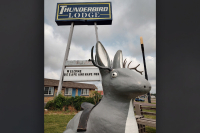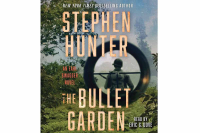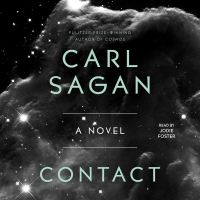Civil War commemoration attracts history fans
 For 10 years, museum curator Jackie Stephens has prepped The Shelton House for Civil War commemorations.
For 10 years, museum curator Jackie Stephens has prepped The Shelton House for Civil War commemorations.
Take a Civil War tour in Haywood County
 With the help of Civil War enthusiasts in Haywood County, The Shelton House Museum of North Carolina Handicrafts has put together a full weekend of events to commemorate the last shot fired in the Civil War east of the Mississippi. Many of the same events are also planned for the weekend of June 12-13.
With the help of Civil War enthusiasts in Haywood County, The Shelton House Museum of North Carolina Handicrafts has put together a full weekend of events to commemorate the last shot fired in the Civil War east of the Mississippi. Many of the same events are also planned for the weekend of June 12-13.
The Fall of Will Thomas
William Holland Thomas, a self-made, prominent businessman, a revered chief in the Cherokee tribe, a politician and a colonel in the Confederate Army, spent the final 20 years of his life fighting mental illness. He passed those years, as he put it, “in a mad man’s cell.” No diagnosis of his condition exists, though biographers E. Stanley Godbold and Mattie U. Russell contend that Thomas was possibly suffering the tertiary state of syphilis, which causes erratic behavior and bouts of insanity.
Like a Good Neighbor: The Eastern Cherokee and the Confederacy
Not all the Eastern Cherokee supported the Confederacy. Several served with the Union army during the Civil War and were ostracized by the Confederate Cherokees after hostilities ceased. Some evidence exists that one of these Union soldiers brought smallpox back to the small band of Cherokees who survived the war, with devastating results.
Last man standing: Waynesville makes history with an untidy ending to an untidy war
 Union Col. William Bartlett tried to keep his cool as he watched his bitter, battle-hardened Confederate enemies riding down Main Street that May morning of 1865.
Union Col. William Bartlett tried to keep his cool as he watched his bitter, battle-hardened Confederate enemies riding down Main Street that May morning of 1865.
SEE ALSO:
• Like a Good Neighbor: The Eastern Cherokee and the Confederacy
• Take a Civil War tour in Haywood County
• The Fall of Will Thomas
• Civil War commemoration attracts history fans
• Bringing the past to life
• ‘Last Shot Fired’ — Civil War 150th anniversary commemoration
They were flying a white flag, but the town was like a tinderbox waiting to spark. Union men had occupied Waynesville the day before, but Confederate militia were rallying in the hills, ready for blood if the parley wasn’t fruitful.
Confederates pushed road over Newfound Gap
On Jan. 12, 1864, a Confederate battery of artillery and about 650 men under the command of Gen. Robert B. Vance crossed the Smokies at Indian Gap — situated at 5,317 feet between Clingmans Dome and Newfound Gap along the high divide between North Carolina and Tennessee — in an attempt to secure provisions, screen the main approaches to North Carolina, and guard the left flank of the Longstreet’s main Confederate force at Greeneville, Tenn.
Civil War crossing of Smokies was memorable feat
The war in the Smokies proved to be … a curious conjunction of terrain, history, politics, and culture ... a tragic division of loyalties … a brutal partisan conflict
where men left homes and wives and children and trekked north in cold and rain … where still others served in nearly forgotten units to protect border and home.
— Noel C. Fisher, The Civil War in the Smokies
One of the remarkable “nearly forgotten” events that took place in the Smokies region during the Civil War occurred at Indian Gap, situated at 5,317 feet between Clingmans Dome and Newfound Gap along the high divide between North Carolina and Tennessee. On Jan. 12, 1865, a Confederate battery of artillery and about 650 men under the command of General Robert B. Vance crossed the Great Smoky Mountains at Indian Gap in an attempt to secure provisions, screen the main approaches to North Carolina, and guard the left flank of Longstreet’s main Confederate force at Greeneville, Tenn.
The primary military objectives failed for the most part, but the crossing itself — accomplished under the most severe conditions — deserves to be remembered for a number of reasons. Described as one of the more “heroic episodes” to take place during the Civil War in the southern mountains, the crossing has been likened to “Hannibal crossing the Alps in miniature.” It involved the Thomas Legion, one of the most colorful forces in the Confederacy, which consisted of a unit put together by Will Thomas made up of both mountaineers and Cherokees. The Indian component of the Legion was initially comprised of 130 Cherokees. Used primarily as scouts, their role in the war involved alleged “atrocities” of scalping made by the northern press. And the crossing took place over the old Oconaluftee Turnpike, sections of which can still be located.
The road was commissioned by the N.C. General Assembly more than three decades prior to the war. Tom Robbins (a now-retired park historian stationed at the Oconaluftee Visitor Center for years) has a long-standing interest in the history of the road. In “Summit Magazine” (Summer 1986), Robbins provided an account of the road’s early history:
“The valley was Cherokee land for hundreds of years before it was given up in a treaty in the 1790’s. By the beginning of the nineteenth century, the first permanent white settlers were occupying land along the banks of the Oconaluftee River. Like many areas throughout the mountains, as the population of the valley grew, so did the need for roads to provide a better means of trade and communication.
“In 1831, the N.C. General Assembly authorized the formation of the Oconaluftee Turnpike Co. to build a road through the valley to the top of the Smoky Mountains. Road commissioners were selected from the local community and authorized to sell stock and collect tolls.
“Construction of the road was difficult and time-consuming. Cliffs and the river had to be avoided, thus lengthening the route. Blasting involved hand-drilling holes in rocks and packing the holes with black powder. Large rocks were sometimes split by burning logs on them, then pouring cold water on the hot rocks.
“The road, completed in 1839, followed an older Indian trail along much of its route. It crossed the Smokies at a point called Indian Gap. Initially, the principal traffic on the turnpike was livestock being driven to market. But not long after the road’s completion several men living in the valley formed the Epson Salts Manufacturing Co. in an attempt to tap the mineral resources [at Alum Cave] on the southwestern side of Mount LeConte in Tennessee.”
Robins believes the turnpike gate was probably situated beside the Oconaluftee River about where the present boundary is situated between the national park and Cherokee lands. He has walked the old road up the north bank of the river from the visitor center to the Smokemont Campground area and on to the Kephart Prong trailhead, where it “sort of gets lost” in the old roadways cut there during the CCC days of the 1930s.
Two of the most visible and accessible sections of the Oconaluftee Turnpike are to be found alongside U.S. 441: (1) at the Kephart Prong trailhead cross the footbridge, proceed 100 yards along the main trail, then follow a side trail (to the right) where the old trace is obvious as it is worn up to five feet deep; and (2) at the Oconaluftee Overlook (just below Newfound Gap), where a clearly defined section winds up from the overlook area toward the Clingmans Dome road along the main ridge.
Accounts differ as to just when Thomas started improving the road. The version published in 1914 by John Preston Arthur in Western North Carolina: A History from 1730-1913 is perhaps the most accurate. Arthur states that Thomas obtained “an order from General Kirby Smith in the spring of 1862 to raise a battalion of sappers and miners ... and put them to making roads, notably a road from Sevier County, Tennessee, to Jackson County, N.C. This road followed the old Indian trail over the Collins Gap [another name for Indian Gap], down the Ocona Lufty river to near what is now Whittier, N.C. [ten miles east of Bryson City].”
In January 1864, the 58-year-old Will Thomas and 125 of the Cherokees joined about 100 infantry, 375 cavalry, and one section of artillery Vance had marched from Asheville to acquire provisions and take up positions in Tennessee. By all accounts the winter of 1864 was unusually cold with considerable snow in the higher elevations. According to William R. Trotter’s Bushwackers! The Civil War in North Carolina (vol. 2, 1988):
“The Indian Gap road that … had been hacked through the mountains toward Sevierville was passable as far as the crest of the Smokies, but beyond that the route was little more than a mule-path: steep, rocky, and too narrow even for an ox cart. But what oxen could not do, men could. At the crest, Vance’s men dismantled their artillery. Teams of men carried the wheels, axles, rigging, and ammunition. The gun barrels themselves were harnessed to ropes and rolled, pushed, or dragged down the far side, gun metal screeching on naked rock. The march was characterized not only by Homeric physical exertion, but also by vile weather; Vance and his men did all this into the teeth of savagely cold winds that scoured the mountain tops like a sand-blaster ....”
After reassembling their equipment at the base of the Smokies, Vance’s men had initial success on Jan. 13 with the capture of a Union caravan of about 30 wagons. But shortly thereafter, flushed and cocky by his “little victory,” Vance was smashed at Schultz’s Mill on Cosby Creek by Col. William Palmer’s 15th Pennsylvania Calvary.”
George Ellison wrote the biographical introductions for the reissues of two Appalachian classics: Horace Kephart’s Our Southern Highlanders and James Mooney’s History, Myths, and Sacred Formulas of the Cherokees. In June 2005, a selection of his Back Then columns was published by The History Press in Charleston as Mountain Passages: Natural and Cultural History of Western North Carolina and the Great Smoky Mountains. Readers can contact him at P.O. Box 1262, Bryson City, N.C., 28713, or at This email address is being protected from spambots. You need JavaScript enabled to view it..
Poignant, touching, revealing: WCU collection of Civil War letters helps mark anniversary of war’s start
Next to Hunter Library at Western Carolina University is a Baptist church with a 190-year-old graveyard. George Frizzell, head of the library’s special collections, helped survey that graveyard 17 years ago.
So when Frizzell spotted a postscript to a letter in WCU’s collection of some 200 Civil War letters written by Western North Carolina soldiers and their families, the archivist described feeling an eerie chill. The names seemed familiar.
“We saw the one with the postscripts about the headstones, I thought, ‘could it possibly be?’” he said. “I walked over and found the grave, and next to it was the smaller stone to ‘Little Charley.”
In that Cullowhee Baptist Church graveyard are two Civil War-era tombstones, side by side; a large one for a Dr. Edmonston, the other one for Charley.
The story of the tombstones is told in a letter written by Maggie Edmonston, Dr. Edmonston’s wife and Charley’s mother. And it seems as relevant now, as the nation observes the 150th anniversary of the start of the Civil War, as when Maggie Edmonston wrote the words “Dear Brothers” in a poignant plea for help to her brothers-in-law. The letter is dated July 14, 1864.
“Will you please go to the marble yard in Petersburg or any yard you may see and select some nice tombstones for Dr. Edmonston’s grave?” Maggie Edmonston wrote from Webster. “Have sent off three times but failed to get any. I know you will take more interest than any buddy else please let me know if you get any so I can send you the inscription if you can get some nice ones let me know I can have them shipped to Walhalla. I want two set one small set for my baby that is all I can do for him and I never will be satisfied until I get that done.”
Dr. Edmonston was a native of Haywood County who is believed to have died here in the mountains from milk sickness after returning, weakened by illness, from the war. He was practicing medicine in Webster when he apparently drank milk poisoned with tremetol, which happens when cows graze on white snakeroot. The reason the couple’s baby died isn’t recorded, though WNC’s old cemeteries provide ample evidence of many babies in the early to mid-19th century also having died from milk sickness.
The 200 or so letters, and WCU hopes to receive even more in the years to come through donations from local families, provide an invaluable look at this region during the mid-19th century. They are being digitized and made available online. The letters demonstrate that though times have changed, human emotions have not. And although most of the Civil War battles were fought on lands far from these mountains, it touched people here as dreadfully as anywhere in the nation. As the war dragged on, it claimed more and more WNC lives, and destroyed more and more WNC families.
George Huntley, a Rutherford County native, wrote his sister Tincy on June 29, 1863, while marching into Pennsylvania as a member of the North Carolina 34th Infantry Regiment: “We are stoped to day in a Beautiful Oke grove I Cant tell whare old Lee Will Carry us tow this is One of the finest Countrys that I Ever saw.”
Three days later Huntley, a school teacher before the war, died from a wound received in the Battle of Gettysburg.
It is those types of details that bring the letters to life for Frizzell.
“The letters summon up the emotional experiences, the concerns and the hopes,” he said. “They speak so much to place, and being here.”
There are letters from Frizzell’s ancestor, M.W. Parris, telling his wife which men had been wounded and killed during the North Carolina 25th Infantry Regiment’s latest battle. The toll included a dozen or so men from Jackson County.
“I am sorry to tel that Som of our brave boys has got kild and Severl wounded in the great battle at richmond which Commenct last wensday,” Parris wrote on July 3, 1862.
Among them: Capt. Coalman’s head was shot off by a cannonball, John B. Queen fell dead as the fight started, Joseph Moody had his fingers shot off, William Cogdal (Cogdill) was wounded in the neck, Leander Hall in the leg, Harris Hooper was struck through the thigh or leg, Major Frances was badly wounded in the shoulder, W. William Beard badly wounded by a shot through his hips.
Parris adds that he believes they’ve won the battle, but describes the victory as “dearly bought” indeed.
Frizzell said Parris clearly penned the letter about the dead and wounded to the community as much as to his wife, Jane.
“These are folks they knew, and he’s trying to let all the wives know — this is how important information was shared,” Frizzell said.
Playing the part: Re-enactor honors heritage by walking in Civil War soldier’s footsteps
Jule Morrow isn’t a rebel; Lynyrd Skynyrd’s “Sweet Home Alabama” isn’t his personal mantra. He doesn’t relive the Civil War, hoping to change the outcome.
“What I honor is the courage,” said Morrow, a Civil War re-enactor whose regiment, the 25th North Carolina Infantry, plays both sides — Union and Confederate. “One thing we all have to remember is the same blood that flowed in those guys flows in us.”
Morrow is named after his ancestor Civil War Capt. Julius Welch and has ties to other prominent Haywood County residents, including the Love, Dillard and Leatherwood families. Although he has never fought in a war, Morrow has re-enacted Civil War battles throughout Georgia, Tennessee, Virginia, North Carolina and Pennsylvania for the past two decades.
About once a month, Morrow and his men in the 25th North Carolina Infantry travel up to nine hours away to participate in re-enactments, depicting both battlefield combat and camp life of the soldiers.
No matter the weather, the re-enactors sleep in canvas A-frame tents with wool blankets, eat rations of hardtack and salted beef, or if they’re lucky, build small fires to roast a chicken or cook stew. They may even scavenge the surrounding area for wild edibles.
While many battles are re-enacted during the course of a weekend, Morrow said he has slept in the field for up to five days.
In addition to reliving camp life, re-enactments showcase the war tactics of the time. Like the Romans, Civil War fighters lined up, confronting their enemy face-to-face.
Occasionally, re-enactors portray specific soldiers in specific battles — replaying the actual movements of the men on the field in real time — for the more well-known and well-documented battles where such records occur. Re-enactors are given background on the person they are depicting, including how, where and when they died or surrendered.
“I like it when you’re a particular soldier,” said Morrow, who once surrendered to Union troops while playing a member of the color guard.
The original 25th infantry back in real Civil War times was one of only a few regiments from the mountains, comprised of men from Haywood, Jackson and Macon counties, plus Buncombe, Henderson, Cherokee, Clay and Transylvania.
But at least half the time, Morrow and his men find themselves donning Union uniforms, playing the part of Union soldiers — after all, a re-enactment wouldn’t be much good without someone playing the other side.
The re-enactors’ alter ego is the 14th Iowa regiment, a Union troop with soldiers from across the western part of the U.S., making its most celebrated stand at the Battle of Shiloh, one of the bloodiest conflicts of the war.
To play both sides, the re-enactors need two sets of authentic fatigues, both grey and blue. All 25th North Carolina soldiers have in their wardrobe a black felt slouch hat, a 100 percent cotton or wool socks, a U.S. 1854 black leather belt and a U.S. 1858 Smoothside canteen, among other items.
To play the 14th Iowa regiment, men must be suited in an enlisted man’s frock, sky blue wool pants and a forage cap. Specialty haberdashers around the country make entire lines of Civil War-era clothing and accessories for re-enactors.
Twenty-five men currently belong to the regiment, down from 56 in 2002. Morrow and some of his compatriots are putting off retirement from re-enacting until the end of the Civil War’s 150th anniversary, a four-year event that promises additional pomp and circumstance.
Before too many re-enactors lay down their bayonets for the last time, Morrow said he hopes to replenish their ranks with new members, and the regiment has plenty of muskets and uniforms to loan new recruits.
For Morrow, the Civil War and its repercussion are an important part of his family history.
“Everybody’s grandma’s got the story of the Yankee that comes and takes their mule,” he said.
Morrow, who describes himself as a proud Southerner, is glad the North won the war.
“If we hadn’t lost the war, today, we would probably be like Europe; we would be 13 countries,” he said. “South Carolina would be their own little country because they can’t get on with anybody.”
A different outcome to the Civil War could also have affected future wars, he added. A divided U.S. might not have defeated Germany during WWI.
Several books and television programs have explored the world of Civil War re-enacting. But, none of them adequately represent re-enactors and many focus on the extremes, Morrow said.
In 2001, a History Channel program “The Unfinished Civil War” drew fire from re-enactors, who said the show depicted them as racists — a group of people for whom Morrow has zero tolerance.
Once during a re-enactment in Tennessee, the 24th North Carolina regiment was portraying Union troops when some Ku Klux Klan members appeared.
“These guys had the audacity to ‘boo’ me,” Morrow said. “I told one of ‘em, I said, ‘Let me tell you something.’ I said, ‘Son, when your wife sees what you’ve done to her jade satin sheets, she’s going to whoop your ass.’”
For Morrow, the Confederate flag is a symbol of Southern pride and part of his family history, but he said he understands why people find it offensive.
“We have allowed our symbol to be trashed by a bunch of ignorant pinhead klansman,” Morrow said. “What we should have done is when we saw them is go just beat the crap out of them and take their flag from them.”
See the re-enactors in action
Civil War re-enactors will be outfitted in in authentic dress, depicting camp life and battles at two upcoming events.
Appalachian Harvest Festival
When: Oct. 15, starting 11 a.m.
Where: Stecoah Valley Center outside Robbinsville
The Battle at Warm Springs
When: Nov. 4 - 6
Where: Hot Springs Resort and Spa in Hot Springs
Rash draws on his own Civil War ties in his new novel, The World Made Straight
By Sarah Kucharski • Staff Writer
History books and literature long have recounted and regaled the Civil War, examined its long-lasting effects in determining who “we” are as a great and unified South, and how “we” are not yet ready to lay down arms between victor and vanquished.













